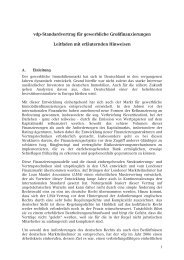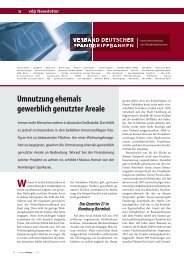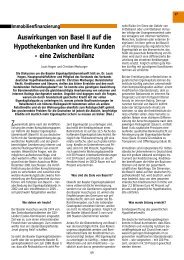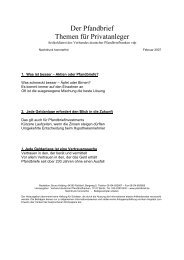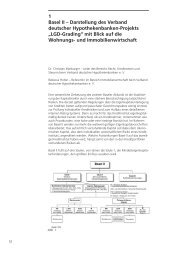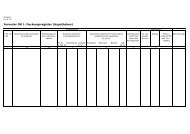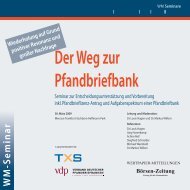Expected Loss Covered Bond Model
Expected Loss Covered Bond Model
Expected Loss Covered Bond Model
Create successful ePaper yourself
Turn your PDF publications into a flip-book with our unique Google optimized e-Paper software.
APPENDIX A1: THE JOINT DEFAULT APPROACH<br />
Under Moody’s EL <strong>Model</strong>, the credit strength of the <strong>Covered</strong> <strong>Bond</strong>s is determined by the combination of (i) credit<br />
strength of the Issuer, and (ii) the value of the Cover Pool. The contribution from the Issuer includes the three<br />
components listed in Appendix B1, and the first of these is the Issuer’s probability of default. The aim of this<br />
Appendix is to show how Moody’s EL <strong>Model</strong> combines the benefit related to an Issuer’s probability of default with<br />
the value of the Cover Pool through a number of worked examples. It should be noted that the examples below<br />
are not intended to be a reflection of specific/particular circumstances, but rather illustrative of how these two<br />
components are combined in the Moody’s EL <strong>Model</strong>.<br />
The examples are based on a number of assumptions which include the following, amongst others.<br />
• The Issuer will either have a senior unsecured long-term rating of A2 or Baa2.<br />
• Following Issuer Default, recovery will arise only from the Cover Pool (i.e. no recovery is assumed from a<br />
full-recourse unsecured outstanding claim against the Issuer, and if relevant, other group companies or<br />
guarantors).<br />
• The <strong>Covered</strong> <strong>Bond</strong>s issued are ‘bullet bonds’ which have a three-year maturity.<br />
• At the time of issue, the nominal balance of the Cover Pool matches the nominal balance of the <strong>Covered</strong><br />
<strong>Bond</strong>s outstanding (i.e. there is no over-collateralisation).<br />
• Cash flows which arise at a future date have not been discounted back to present value.<br />
• For the purposes of the example, following Issuer Default, losses in respect of the Cover Pool are<br />
assumed at a level, respectively, of 3% and 12% of the Cover Pool. 7<br />
• The examples will make use of Moody’s idealised tables, respectively for probability of default (“Moody’s<br />
PD Tables”) and expected loss (“Moody’s EL Tables”) which are included in this report in Appendix F1.<br />
The results of the following four examples are shown below.<br />
Example 1: assumes Issuer rated A2 and, following Issuer Default, losses on the Cover Pool 3%<br />
Example 2: assumes Issuer rated A2 and, following Issuer Default, losses on the Cover Pool 12%<br />
Example 3: assumes Issuer rated Baa2 and, following Issuer Default, losses on the Cover Pool 3%<br />
Example 4: assumes Issuer rated Baa2 and, following Issuer Default, losses on the Cover Pool 12%<br />
To show how these results were obtained, example 1 is considered.<br />
The first step is to calculate the probabilities of default of the Issuer over the life of a three-year covered bond.<br />
These are taken from Moody’s PD Tables which are found in Appendix F1. As seen from this table, the probability<br />
of default of an A2-rated Issuer in one year is 0.011%, and the probability of this Issuer defaulting in year two is<br />
0.059% (the probabilities in the Moody’s PD Tables are cumulative, i.e. 0.070% - 0.011% = 0.059%).<br />
For this example, the loss of the Cover Pool following Issuer Default is simply assumed to be 3%. To calculate the<br />
expected loss for each of the years of the life of the <strong>Covered</strong> <strong>Bond</strong>, the product of this 3% and the probability of<br />
default for each year is calculated. The aggregate expected loss is then calculated by summing the expected<br />
losses for each of the three years of the life of the <strong>Covered</strong> <strong>Bond</strong>.<br />
This example is reproduced in table form below.<br />
Year<br />
Probability of<br />
Issuer Default<br />
<strong>Loss</strong> on Cover Pool following<br />
Issuer Default<br />
<strong>Expected</strong> <strong>Loss</strong><br />
on <strong>Covered</strong> <strong>Bond</strong><br />
1 0.011% 3% 0.000%<br />
2 0.059% 3% 0.002%<br />
3 0.152% 3% 0.005%<br />
Cumulative <strong>Expected</strong> <strong>Loss</strong> of the <strong>Covered</strong> <strong>Bond</strong> 0.007%<br />
The cumulative expected loss of the <strong>Covered</strong> <strong>Bond</strong> is then mapped to the corresponding three-year rating in the<br />
Moody’s EL Tables. In this case this results in a Aa1 rating, which is four notches above the Issuer rating.<br />
7<br />
These percentages are assumed to be the aggregate of the following categories of loss: (i) loss due to credit quality of the Cover Pool, (ii) loss<br />
as a result of refinancing risk, and (iii) loss arising from market risks (or exposure to unhedged market risks).]<br />
European <strong>Covered</strong> <strong>Bond</strong> Rating Methodology Moody’s Investors Service • 5




